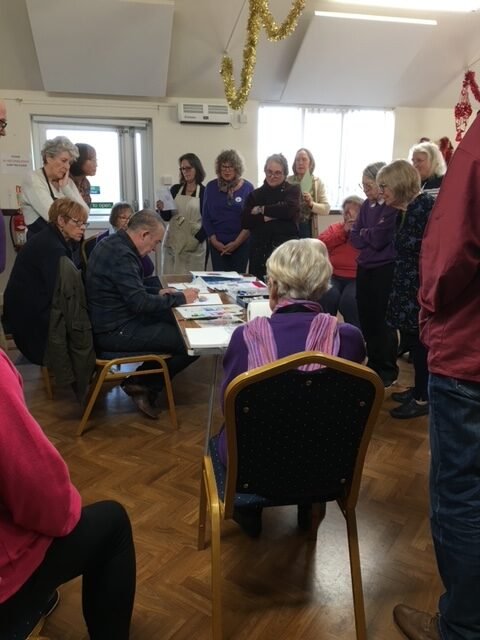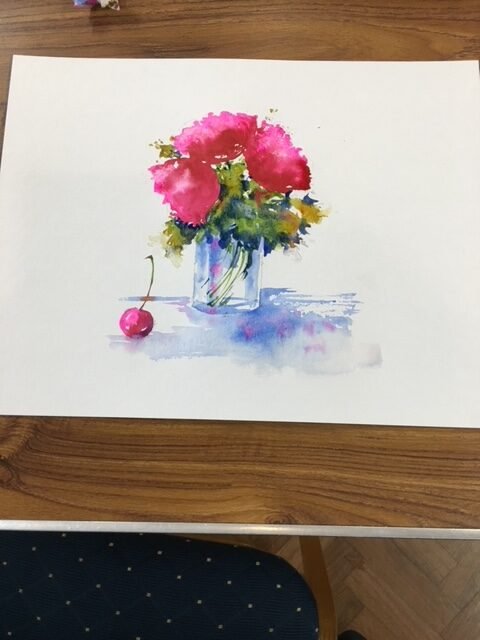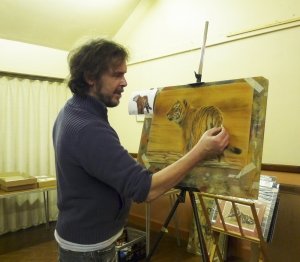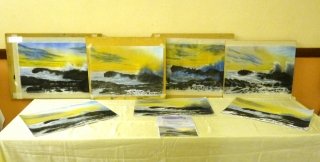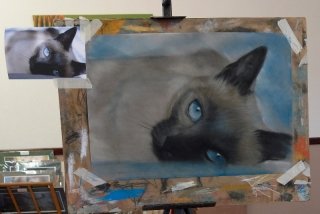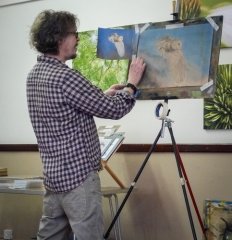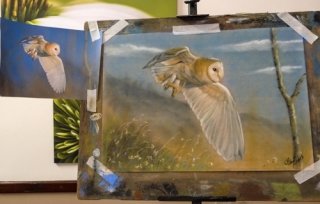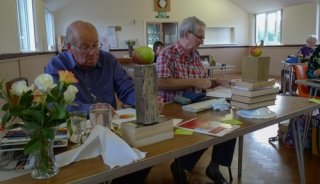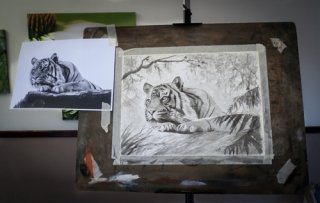Please check the meetings page for dates of workshops and demonstrations.
We try to hold workshops regularly where each member attending can create their own painting following step by step instructions from an artist. The workshops can be half day or more usually, full day (10:00 am – 4:00 pm). Many members prefer workshops to demonstrations because they learn techniques more thoroughly, get individual attention for any problems and go home with a finished or almost finished work of art.
The photos and descriptions below show the sort of thing we get up to:
In September Jackie Whall gave a Speedie Portraits workshop It was a smaller turn out than usual however group of determined enthusiasts came for a great day of painting. Portrait painting isn’t everybody’s cup of tea but Jackie works her magic and encourages you do the very best you can and this workshop certainly produced some wonderful paintings as you can see at the end. She started the session by demonstrating a more classical technique for speedie portraits. Armed with just 6 colours she showed us how to create colours suitable for most portraits. Happily you can use this technique with both oil and acrylic. No elaborate drawing required – just look at the picture and draw what you see using your paintbrush. She used burnt umber for the initial outline and for putting in the basic tones then added skin tones once the shape and form is complete. That’s all there is to it – simple!! Then it was our turn. Armed with a selection of pictures we started our journey. Speedie painting is just that – no detail just getting the paint down quickly using big brushes and lots of enthusiasm. If it all goes wrong just wipe it off and have another go! Jackie is always on hand to point us in the right direction and encourage us to be BOLD. After coffee and cake (thank you Lesley) she showed us another technique. This one could definitely push some of us out of our comfort zone because instead of outlines it’s about finding shapes and painting them. In some ways this is much easier especially if faces and proportions fill you with trepidation. If you really wanted you could paint the picture upside down. Armed with this knowledge it was off to do our second painting. No fiddling allowed – my downfall as I’m a detail freak? . Big brushes certainly help. What was very noticeable was just how quiet it was in the room as people beavered away and there was a definite reluctance to stop for lunch. Eventually we stopped for lunch and took the time to wander around admiring people’s efforts and chatting about the different techniques. In the afternoon people became a little more adventurous choosing non standard portraits to do. Many of the pictures resembled a Smurf convention, blues, yellows and reds. Surprisingly it made you focus on getting the proportions right as well as the tones. One trick we learnt along with many others was to remember to blend as you go so there are no stark lines. Fingers and scruffy brushes are great for this. Jackie reminded the oil painters about trying to put light colours over dark when the paint is wet… it doesn’t work so we had to give our actions a bit of thought. At the end of the day we all left with our paintings and a sense of achievement of a job well done. Julie 
On 25th June Lynne Whitfield gave another master class for the members encouraging them to draw an eye using another new technique for many. After covering the paper with either graphite or charcoal she demonstrated how to observe tones to bring out the eye from. A bit nerve racking for some used to drawing the eye and “filling-in” areas. Gradually the eyes emerged by adding more graphite or subtracting using a putty rubber. Below are some of the excellent results:
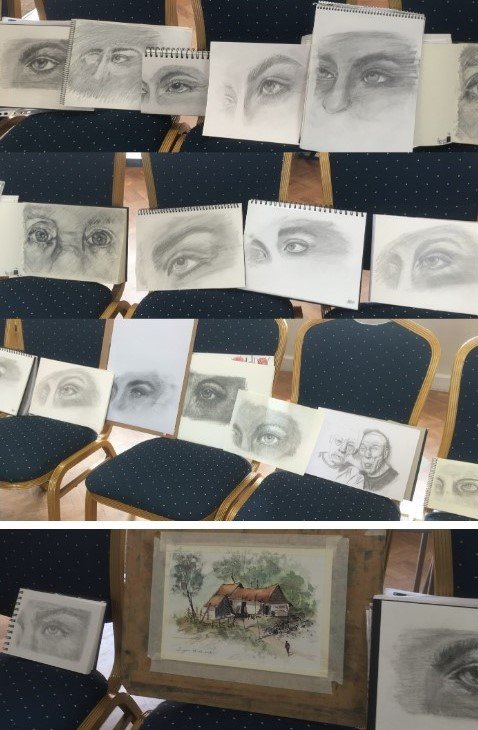 On June 6th 2024 Lynne Whitfield, our in-house tutor, delighted a full house with her Cheeky Puffins workshop.She started by explaining that Puffins mate for life and her photograph choice showed two puffins who were obviously a pair. The first challenge was to get the body language right – not as easy as it seems. We all started by exploring how to get the image down. Lynne demonstrated how to get the basic outline by good observation and the minimum of outline, explaining that details would come later during the painting stage. Then it was our turn and some excellent drawings emerged. It was obvious from the quietness in the room that it required a concentrated effort.
On June 6th 2024 Lynne Whitfield, our in-house tutor, delighted a full house with her Cheeky Puffins workshop.She started by explaining that Puffins mate for life and her photograph choice showed two puffins who were obviously a pair. The first challenge was to get the body language right – not as easy as it seems. We all started by exploring how to get the image down. Lynne demonstrated how to get the basic outline by good observation and the minimum of outline, explaining that details would come later during the painting stage. Then it was our turn and some excellent drawings emerged. It was obvious from the quietness in the room that it required a concentrated effort.
After a short tea break (with excellent cakes) to boost our energy levels it was on to the painting stage. Imagine our horror when she asked us to completely cover the drawing with blue paint but thin
enough to still see the drawing below. Next Lynne surprised us by using purple! Not the colour you would imagine for a black and white bird. Once we had identified all the black areas and loosely painted them in purple it was onto the next colour, this time red and not just on the beak. Lynne explained that the painting would become more psychedelic as we added more bold colours. A technique definitely not for the faint hearted.
Then came orange followed by yellow and finally cerulean blue for the shadows that we had to look hard to find. Lunch found us all wondering just what our finished product would look like. Undaunted it was back to the paints and finally we got to use white. To ensure the colour beneath would show through the first layer it had to be very thin.
Gradually the painting emerged and the white areas began to glow. Rather than paint the feathers we used the paint to suggest the direction and with the underlying shadow painting the birds took both shape and form. All this was done with a large brush and for those used to detail brushes it was a new experience and slightly nerve wracking. Finally though we were allowed to get out the fine brushes to add the all so important details like the eyes and the glorious beaks.
At the end of the session the paintings were gathered together so we could appreciate the diversity and excellence of our paintings. Examples of which are shown below. Our thanks go to Lynne for taking us out of our comfort zones and showing us that all painting techniques are not necessarily what they first appear and that it’s good to try something new.
On November 14th 2023 we had a workshop with Andrew Geeson. Here’s a sum up of the day from Julie Stevens:
Andrew Geeson an exponent of loose watercolour painting gave a lively and encouraging workshop. The day started with a couple of exercises to loosen up our minds as well as our painting and followed with the first of two demonstrations. Interestingly he showed how to pare down our drawings to the very basics to ensure we didn’t just fill in the spaces and ensure we allowed the paint to flow.
The resulting drawings and paintings were excellent – lively and full of clear colour. The afternoon session was a little more advanced and he showed us how to move paint on the paper without muddying colours and loosing impact. Once again the drawings and painting were excellent.
Everyone enjoyed the experience so much so that he has been asked to return to show us how we can apply his technique to painting buildings with some of his flowers adorning them.
In August 2023 Vic Bearcroft made a very welcome return to MAG. We had a lovely workshop where we painted a tiger in pastels on black velour. We all learned quite a lot from how to work on black velour to finding out the collective noun for tigers is a streak! So here’s our streak of tigers (all are WIP):

In May 2022 Lynne Whitfield hosted a portrait workshop in bot water colour and acrylic. Here are the results of a very enjoyable and informative day:
In February 2018 Gareth Watling made a very welcome return visit to hold a kingfrisher painting workshop
April 2018 saw Lynn Whitfield here again to show us how to paint in loose watercolours. I think you’ll agree we all managed to produce some amazing hares
    |
|
Gwen Scott using watercolours, showed us her method of painting flowers and adding leaves afterwards with amazing effects:
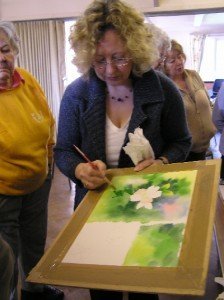 |
Gwen shows us her technique for adding leaves to paintings of flowers |
| Gwen’s finished and unfinished paintings |  |
November 2015 saw our old friend Liz Haywwod back for a watercolour workshop. Using Clumber Park as a reference we learnt how to tackle reflections in water.
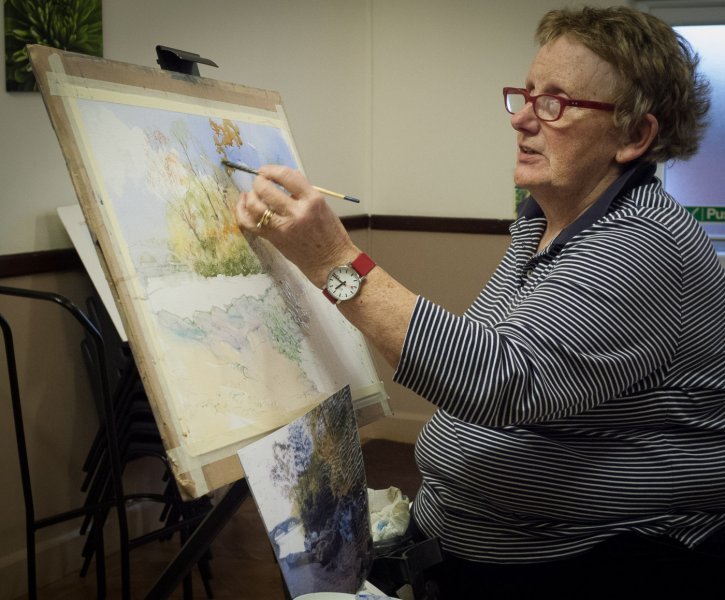 |
 |
Gwen Scott held a watercolour workshop in 2014 where we painted flowers around a cottage door. It was good to see such varied results. All good I hasten to add!
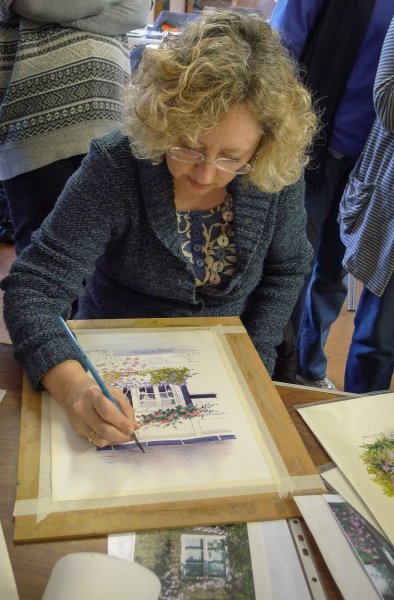 |
 |
Vic Bearcroft’s subject was a Indie the tiger. Vic provides a photo for us to use as a reference and we worked with pastels on velour paper:
| Vic showing us how he achieves his wonderful effects | |
| The group showing off their paintings |
At another workshop Vic Bearcroft showed us how to paint a seascape in pastels on velour:
In April 2012 Vic Bearcroft showed us how to paint a Siamese cat’s head in pastels on velour:
|
This is Vic’s painting from the photo |
|
| And these were our attempts |
In July 2011 Tas Severis came to show us how to paint a sea scene in pastels on velour
|
This is Tas painting his seascape |
|
| And these were our attempts |
In February 2013 Vic Bearcroft came again to teach us how to paint an owl in pastels on velour
|
This is Vic painting his owl from a photo |
|
| And this was the finished piece
|
In May 2013 Terry Harrison ran a workshop in painting a quayside in watercolours. He showed us some very useful brush techniques too.
|
This is Terry painting his version |
|
And these were our attempts
In September 2013 Mick Lakin, the botanical artist, taught us how to go about drawing and painting apples and pears as botanical illustrations
|
This shows some of the members concentrating on their subjects |
|
On 23rd November 2015 our old friend Vic Bearcroft came to see us again to show us how to paint using his latest technique – indian ink. Only ink was used to create this tiger
|
|
|




